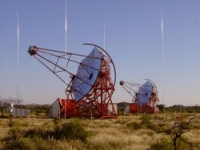The High Energy Stereoscopic System (H.E.S.S.) is a next-generation system of Imaging Atmospheric Cherenkov Telescopes (IACT) for the investigation of cosmic gamma rays in the 100 GeV and TeV energy range. The acronym was chosen in honour of Victor Hess, who was the first to observe cosmic rays.
The name also emphasizes two main features of the currently-operating installation, namely the simultaneous observation of air showers with several telescopes, under different viewing angles, and the combination of telescopes to a large system to increase the effective detection area for gamma rays.
H.E.S.S. permits the exploration of gamma-ray sources with intensities at a level of a few thousandth parts of the flux of the Crab Nebula. H.E.S.S. has four telescopes, each with a mirror just under 12m in diameter, arranged 120m apart from each other in a square. A larger telescope with a 30m mirror called H.E.S.S. Phase 2, constructed in the centre of the array, saw its first light at 0:43 a.m. on 26 July 2012.
As with other gamma-ray telescopes, H.E.S.S. observes high energy processes in the universe. Gamma-ray producing sources include supernova remnants, active galactic nucleii and pulsar wind nebulae. It also actively tests unproven theories in physics such as looking for the predicted gamma-ray annihilation signal from WIMP dark matter particles and testing lorentz invariance predictions of loop quantum gravity.
The H.E.S.S. observatory is operated by the collaboration of more than 170 scientists, from 32 scientific institutions and 12 different countries: Namibia and South Africa, Germany, France, the UK, Ireland, Austria, Poland, the Czech Republic, Sweden, Armenia, and Australia. To date (Aug. 2012), the H.E.S.S. Collaboration has published over 100 articles in high-impact scientific journals, including the top-ranked ‘Nature’ and ‘Science’ journals.








































































